Traveling to Valencia and planning to use public transport to move around? Valencia’s public transportation system is a network of metros, trams, buses, bike lanes, and ride-sharing services. This network is highly efficient, safe, and clean, making it easy to reach almost any part of the city in under 30 minutes.
In this article, I’ll cover all the different modes of transport available, what types of tickets you can use, each service’s operating hours, and some insider tips to help you have a smooth and enjoyable experience.
In This Article
What is the best way to get around in Valencia?
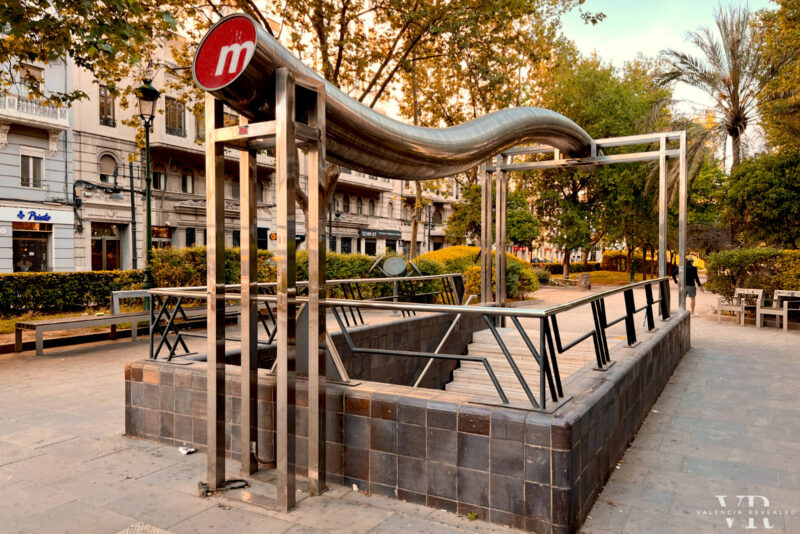
The best way to get around Valencia is by metro. The underground metro system in Valencia is inexpensive, fast, reliable, and clean. It reaches the airport and various neighborhoods but also connects Valencia with the nearby villages.
However, you cannot go everywhere by metro and sometimes you’ll have to take the bus. The bus network is more extensive and reaches all neighborhoods. You can also take a bus to go to a number of villages and commercial centers outside Valencia.
Biking is another great alternative to the underground metro, having a huge advantage in that it’s environmentally friendly. There are over 175 km of bike lanes all over Valencia and you can even go on day trips outside Valencia by bike.
Last but not least, taxis and ride-sharing services really come in handy when you have a lot of luggage or need a ride at night, outside of the metro’s operating hours.
As you can see, the best public transport method in Valencia depends on where and when you want to travel.
If you are only visiting Valencia for a few days, you’ll likely not need to use public transport more than on a handful of occasions.
Valencia is a very walkable city and depending on where you’re staying, you might be able to walk pretty much anywhere and have little need for public transport.
If you want to avoid using public transport as much as possible, I recommend staying in the Old Town. This way, most tourist attractions will be within walking distance from your accommodation.
When staying in the Old Town, you’ll only need to take public transport to go to the beach, the El Cabanyal neighborhood, the City of Arts and Sciences, and Bioparc. If you have time to spare and don’t mind a long stroll, the last two are also reachable on foot from the city center.
If you haven’t booked your accommodation yet, check out the best neighborhoods to stay in Valencia as well as the top boutique hotels in Valencia.
Taking the metro and tram in Valencia
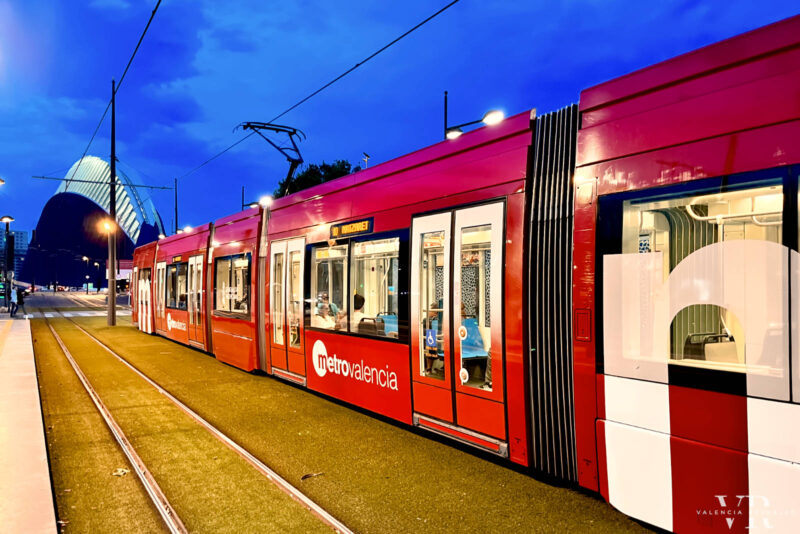
Both metros and trams in Valencia are part of the same network, called MetroValencia. There are 10 lines – 6 metro lines (lines 1, 2, 3, 5, 7, 9) and 4 tram lines (lines 4, 6, 8, 10).
Trams and metros in Valencia are a clean, fast, reliable, and inexpensive way of moving around the city. All coaches are air-conditioned.
Service frequency is 10 minutes on average but it varies greatly between individual lines and the time of the day. Usually, several metro lines share the same stops and routes in the city center, often reducing the service frequency to 5 minutes, especially during rush hour.
As a consequence, the metro in Valencia is rarely crowded to the level that it feels uncomfortable.
Benefits of using the metro in Valencia
There are a number of benefits to using a metro in Valencia.
- Kids under 10 travel for free (up to 2 kids per adult)
- You can take your e-scooter or folded bike on the metro or tram. Unfolded bikes can only be taken on board on overground segments of the MetroValencia network and on underground segments on weekends only
- Assistance dogs, as well as small animals, such as cats and small dogs, can travel on the metro in a closed carrier
- Metro and tram stops are announced well in advance, so you don’t risk missing your stop
Metro and tram zones
Valencia’s metro and tram network is divided into three zones. Zone A, B, and the airport.
Zone A covers the entirety of the city of Valencia and several nearby villages. If you are only visiting Valencia for a few days, this is the zone you are interested in.
Zone B covers a bunch of villages that are further away from the city. Metro lines reaching these villages run at a low frequency – 1 or 2 per hour.
A third zone, which appears as zone C or + on MetroValencia maps consists exclusively of the Aeroport metro stop. The metro fare to the airport is a bit higher (€4.80), however, the airport is located only 10 km from Valencia city center or 25 minutes from the city center.
Metro and tram operating hours
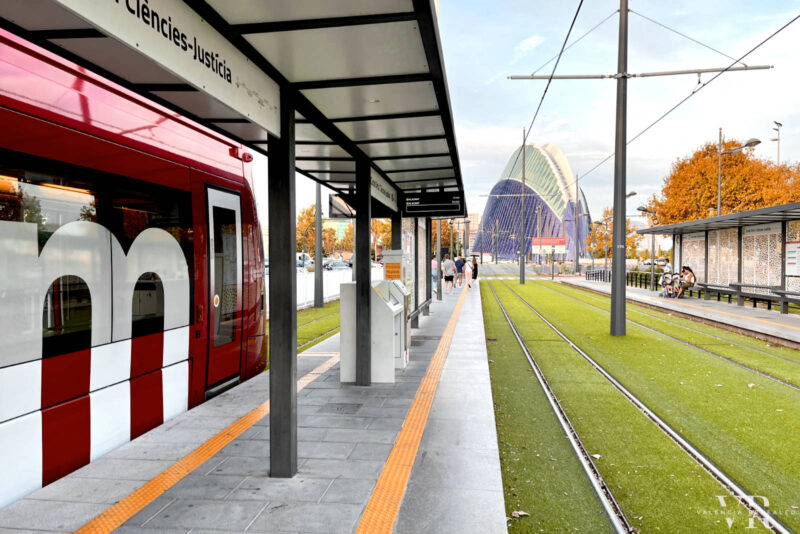
Each metro and tram line operates on a slightly different schedule. For this, it’s best to check the exact timetable for the route you’re interested in.
As a general rule of thumb, metros and trams in Valencia stop pretty early. Which is surprising for a city that goes to sleep so late.
To give you an idea, trams, and metros in Valencia start running around 6 AM.
From Sunday to Thursday, the last service is somewhere a little after 10 PM. On Fridays, Saturdays, and public holidays, however, trams and metros run until almost 3 AM, with a maximum of 3 services per line per hour after midnight.
How to buy a metro or tram ticket
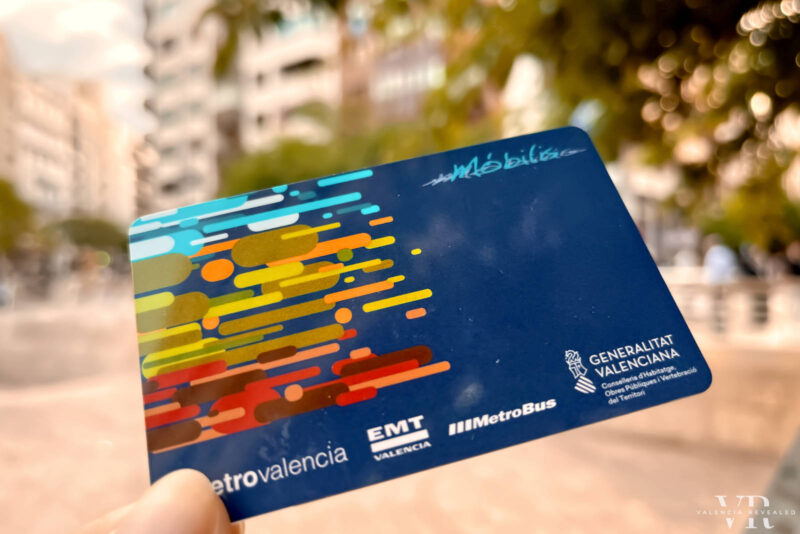
Metro and tram tickets can be bought at any metro station and on tram platforms.
You can use the vending machines to buy single tickets or Móbilis travel cards.
For single journeys, you can also pay directly with your credit card, smartwatch, or mobile phone, without the need to purchase a Móbilis card. This option is currently being implemented and might not be available in all metro stations yet.
The vending machines offer multiple language options, and you can easily switch between them by tapping on the small flags displayed on the screen.
In popular transport hubs such as Àngel Guimerà, Xàtiva, and Colón there’s always somebody to help you with your purchase.
You can pay in cash or by card.
When you purchase your first Móbilis travel card, you will be charged €1 extra for the paper card or €2 extra for the plastic, more durable card.
When the number of journeys on your card runs out, you reuse it by topping it up.
If you want to see how many journeys you have left, you can do so by simply inserting your card into the smaller card readers available in metro stations.
Types of metro tickets available
Several types of tickets and passes are available, which can be confusing. Here I’ll only highlight 3 of them, which I believe are the most useful for someone visiting or even living in Valencia, but who doesn’t use public transport on a daily basis.
Note: A temporary financial aid is currently in place until December 31st, 2023. This means you’ll get a 50% discount on all SUMA 10 and TuiN card purchases. The prices shown in the article are the normal prices.
- Single ticket – €1.50 per journey within zone A and €4.80 for going to the airport (there are no discounts for round trip tickets)
- SUMA 10 – €0.80 per journey within zone A. This is a multi-ticket rechargeable card. The minimum top-up amount is €8. It is zone specific – once you top it up, you can only use it to travel within that particular zone. It can be used on MetroValencia, EMT, MetroBus, and RENFE Cercanías (basically, on the entirety of Valencia’s public transportation network).
- TuiN card – €0.80 per journey within zone A and €2 for going to the airport. This is a multi-ticket rechargeable card. The minimum top-up amount is €5. It can only be used on the MetroValencia network (metro and tram). The biggest advantage of this card is that it can be used in multiple zones.
Important: Both the SUMA 10 and TuiN cards can be used for groups of up to 15 people traveling together. This is important because you can purchase one card for your whole party.
How to validate your metro ticket in Valencia
Remember to always validate your ticket before getting on the metro or tram. If you fail to do this, you risk a fine. You might also have to tap your ticket on the way out.
Validating your ticket on the way in
Underground stations in the city center usually have full-panel ticket gates. To open the gates, tap your ticket or transport card on the red circle.
Most tram stops in Valencia, as well as some above-ground metro stations (often on the outskirts of the city), have free access to the platforms. Here too, you’ll have to tap your card on the red circle before getting on the metro or tram.
Tapping your ticket on the way out
On your way out you’ll also have to tap your ticket. But there are some exceptions.
When using the metro, you always have to tap your ticket on your way out, whether there’s a turnstile gate or not, to avoid being overcharged.
When using the tram, however, if there’s no turnstile gate, you don’t need to validate your travel card when you get off, since all tram stops are in zone A. But, if there is a turnstile gate, you’ll have to validate your ticket for the gates to open.
Tip: If you have several travel cards, remember to use the same one to validate both on your way in and on your way out.
Good to know when using the metro in Valencia
Here are some practical tips for using the metro in Valencia.
- The maximum travel time per journey is 90 minutes from the moment you validate your ticket (within one travel zone). During this time, you can transfer between tram and metro lines as needed
- You can only travel in the zone your title is valid for
- Metro lines 3 and 5 connect the airport to the city center
- Metro line 5 also connects the airport to the seaside neighborhoods. If your accommodation is close to the beach, change to tram line 6 or 8 at Marítim. You’ll have to tap your ticket again at Marítim – you won’t be charged extra
- Get off at either Àngel Guimerà, Xàtiva, Colón, or Alameda station for the city center
- No metro line goes all the way to the beach. For Playa del Cabanyal, take tram lines 4, 6, or 8. For Playa de la Malvarrosa, take tram lines 4 or 6.
- To go to the City of Arts and Sciences, take tram line 10 from the city center
Using the bus in Valencia
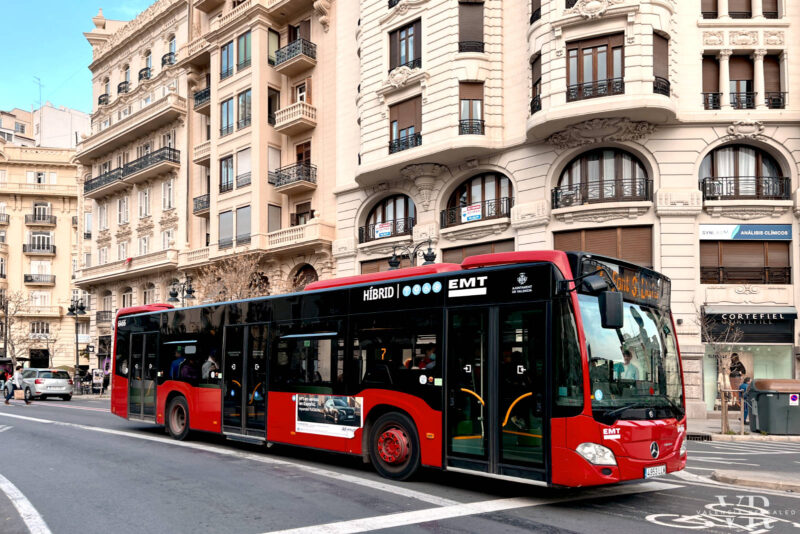
Valencia has an extensive bus network that reaches all neighborhoods. Buses in Valencia are clean, comfortable, safe, and a great way to travel if you want to enjoy the cityscape. All buses in Valencia have air conditioning.
Valencia is served by two types of buses – EMT city buses (red) and MetroBus buses (yellow). The latter connects Valencia with the nearby villages and commercial centers on the outskirts of the city.
Using the bus in Valencia is a great option if you want to reach a part of the city that doesn’t have a metro or tram stop nearby.
But using the bus comes with a few limitations to take into consideration.
- Bus journeys typically take longer than metro rides
- The duration of bus trips is dependent on traffic conditions
- Buses usually tend to be more crowded compared to the metro, particularly during peak hours
Below I’ll be talking about EMT city buses only.
Bus lines
EMT has a fleet of nearly 500 buses. Many of them are hybrid electric.
There are 45 bus lines operating in the city during the day. The frequency of the service varies between individual lines.
During peak times many lines have a frequency of approximately 10 minutes. But they tend to be less frequent very early in the morning and late at night, as well as during weekends and on public holidays.
During the night, there are approximately a dozen bus lines operating in Valencia. These buses are called CorreNIT and they run at a frequency of approximately 1 to 2 hours.
How to pay for the bus in Valencia
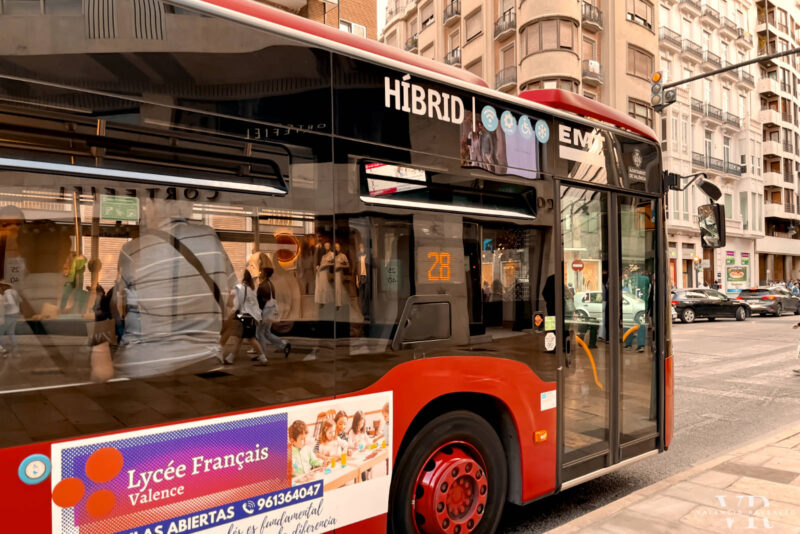
Tickets can be purchased directly on the bus, as well as from EMT offices, kiosks, and tobacco shops around the city.
For single journeys, you can pay in cash to the driver (having exact change is recommended). You can also pay with your credit card, smartwatch, or mobile phone.
If you have a Móbilis card, tap it on the red circle as soon as you get on the bus.
Types of bus tickets available
EMT offers several types of bus tickets and passes. Out of all the options, I will only emphasize 3 that I believe can be the most beneficial for visitors and infrequent users of Valencia’s public transportation system.
Note: A temporary financial aid is currently in place until December 31st, 2023. This means you’ll get a 50% discount on all SUMA 10 card purchases. The prices shown in the article are the normal prices.
- Single ticket – €1.50 per journey (there are no discounts for round-trip tickets)
- SUMA 10 – €0.80 per journey. This is a multi-ticket rechargeable card. The minimum top-up amount is €8. It can be used on EMT, MetroBus, MetroValencia, and RENFE Cercanías (basically, on Valencia’s whole public transportation network). Zone specific.
- EMT Mascota – a personalized card for pets under 15 kg traveling in a carrier. It costs €5 and is valid for an unlimited number of journeys. It has to be renewed every 2 years.
Good to know when using the bus in Valencia
Here are a few things you should know when using the bus in Valencia.
- You have to put your hand out to signal the bus driver to stop. This is particularly important if a bus stop is used by several bus lines
- Use the front door to board the bus. Use the rear door to exit
- Pay or validate your travel card as soon as you get on the bus by tapping the red circle next to the driver
- Press the “Stop” button in advance to let the driver know you want to get off at the next stop
Biking in Valencia
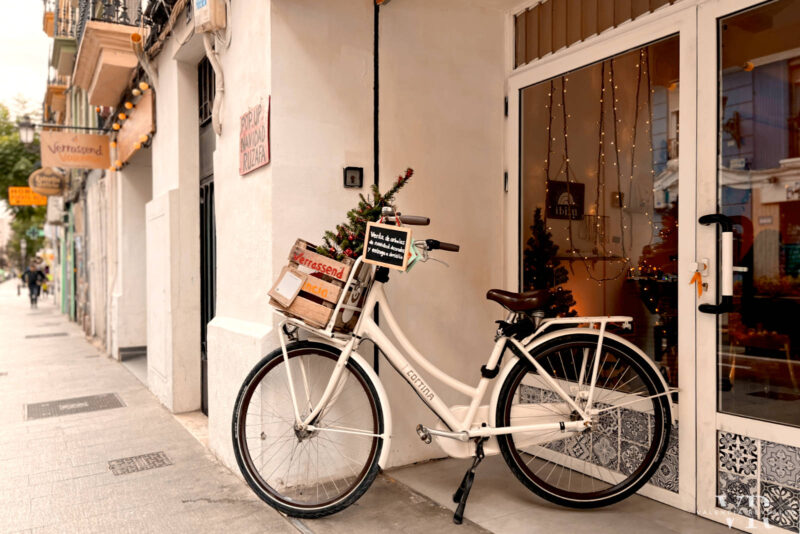
Biking is another great mode of transportation in Valencia and it comes with a lot of freedom and flexibility to explore.
As one of the most bike-friendly cities in Spain, Valencia has over 175 km of bike lanes reaching all neighborhoods and even some of the nearby villages.
On top of that, the city is pancake flat and has a 9 km long green lung that crosses the city from east to west. This is known as Turia Park, a former riverbed converted into a lush public garden.
The weather in Valencia is pleasant year-round. Even winter in Valencia sees day temperatures within double digits Celsius. This means no freezing cold hands while riding your bike during the cold months, which in Valencia are basically January and February only.
If you need even more reasons to hop on a bike, then the fact that it’s a healthy, cheap, and environmentally-friendly way to get around should seal the deal.
If your preferred mode of transportation is biking, then in Valencia you basically have 3 options.
Bike sharing
The bike-sharing scheme in Valencia is called Valenbisi. They have a fleet of approximately 2,750 bikes and over 275 docking stations throughout the city.
Not only are they accessible, but they are also cheap – €13.30 per week or €29.21 per year.
This is the cost of the basic subscription and it comes with 30 free minutes for every ride. If you use the bike for trips exceeding 30 minutes, additional charges will apply for every hour that passes.
Valenbisi is a great option to get around Valencia on the cheap. But it’s not a good option if you want to explore the city stress-free and without looking at your watch every 5 minutes.
Also, if you want to go on a day trip to Albufera or visit the tigernut fields in Alboraya, it can get pretty expensive.
Another caveat is that Valenbisi bikes are heavy and they only come in one size. If you are in Valencia with kids, you might want to look into other options.
Bike subscription
If you plan on staying in Valencia for more than a month, a bike subscription might be just what you’re looking for.
Kleta is a bike rental company located in Ruzafa. They have both bikes and e-bikes and their subscription starts from €19.90 per month and €44.90 per month respectively.
This includes unlimited repairs and an anti-theft guarantee for peace of mind. You can also customize your bike with a basket or child seat.
Bike rental and tours
If you’re in Valencia for a few days only, you can either rent a bike per day or join a guided bike tour.
Bike rentals in Valencia usually start from €10 per day and you can choose from a variety of bike sizes.
Most guided bike tours start in the city center. Some of them will take you to the beach, others to the City of Arts and Sciences, or show you around the historic center.
Also read: Top Biking Routes in Valencia (+ Other Useful Tips)
Ride-hailing services in Valencia
Because Valencia is such a compact city, taxis and similar ride-hailing services are not top of mind when thinking about public transport. But they do come in handy if you are traveling late at night or have a lot of luggage.
Hailing a taxi
To hail a taxi, you can either call by phone, use the FREE NOW app, take a taxi from a taxi rank, or put your hand out when you see a taxi with a green light – this means the taxi is available.
All taxis in Valencia run on a meter. Night rates are higher than day rates. A minimum trip cost applies – €4.30 during the day and €6.40 during the night.
Cabify and Uber Taxi
Cabify and Uber Taxi operate in Valencia. Both companies have clearly branded cars. Ordering a ride is through their respective apps.
Disclaimer: Please note that the information provided in this article is solely intended for informational purposes. Rates, schedules, and conditions related to public transport are subject to change without prior notice. While I strive to ensure the accuracy of the information contained in this article, I highly recommend that you verify the details with the relevant service providers before your trip.







Hola Lara, That was a really informative detailed article on Valencia transport system. Thank you so much for sharing this article. I wanted to ask you how is the train system in Valencia? Can we ride trains from Valencia to reach other Spanish cities for example: Barcelona, Madrid, Seville, Granada, Cordoba or Malaga?
I am looking forward to hear from you soon.
Yes, you can take a train from Valencia to several major Spanish cities, but in some cases, flying can be faster/cheaper. That being said, the best way to reach Madrid is by fast speed train. All the other cities you’ve mentioned are 3+ hours away by train. Spanish trains are comfortable and clean and I highly recommend them.